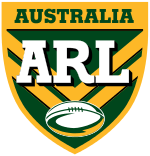Australian Rugby League
| Australian Rugby Football League | |
|---|---|
 | |
| Founded | 1924 |
| RLIF affiliation | 1948 |
| Responsibility | Rugby League in Australia |
| Headquarters |
Rugby League Central. Driver Avenue, Moore Park, Sydney |
| Competitions | National Rugby League |
| Website | www.RugbyLeague.com.au |
The Australian Rugby Football League,[1] more commonly known as the Australian Rugby League (ARL), was the governing body for the sport of rugby league football in Australia. The ARL, as a corporate entity, was handed over to the new Australian Rugby League Commission.[2] at 9:30am on 9 February 2012. Since its inception the ARL administered the Australian national team and represented Australia in international rugby league matters. During the mid-1990s' Super League war the ARL administered the country's first-grade premiership until the National Rugby League was formed. The legal hand-over from ARL to ARL Commission ensured that the game has effectively had the same governing body across Australia, since 1924.
Competitions
The ARL controls high-profile club competitions like the National Rugby League and National Youth Competition as well as annual representative competitions such as the State of Origin series, the Indigenous All Stars Match, City vs Country Origin and the Affiliated States Championship.
Other leagues include:
- Australian Secondary Schools Rugby League
- Australian Universities Rugby League
- School Sports Australia
- Australian Police Rugby League Association
- Australian Women's Rugby League
History
Initially formed as the Australian Rugby League Board of Control on December 1924, it was created to administer the running of the national team. George Ball was the first secretary of the Board and John La Maro the first chairman. Prior to this time, international rugby league was organised by both the NSWRL and the QRL. It was only after this time that the Australian team began to wear the now familiar sporting colours of Green and Gold.
Until 1984 the ARL was run by the NSWRL board, and many Queensland players and administrators throughout this period believed that the NSWRL used this power to the detriment of Queenslanders, especially with respect to national team selection. In 1984 the ARL was duly incorporated, as a separate entity, and Ken Arthurson was the first executive chairman of the new body. With national expansion of the competition implemented for the 1995 season the NSWRL passed control of the Winfield Cup competition to the ARL.
Following Kerry Packer's announcement that his Optus Vision company owned both free-to-air and pay television broadcasting rights for the sport in Australia, News Corporation, controlled by Rupert Murdoch, undertook a bold bid to create a rival competition, Super League (Australia). Super League successfully attracted eight of the ARL clubs.[3]
In the 1995 State of Origin series, the ARL forbade the players of those eight clubs from participating in the interstate competition. However, those clubs were allowed to participate in the premiership seasons of 1995 and 1996, while the ARL fought in the courtroom to stop the Super League competition from eventuating. However, Super League conducted a rival competition in 1997.
Both the ARL and Super League competitions ran parallel to each other that year. At the close of the season, despite having the financial backing of Optus, the ARL decided that it could not survive if two competitions were run and undertook moves to approach News Corporation and join the national competition that had been created by Super League. As a consequence of the negotiations that followed, the National Rugby League was formed before the 1998 season from the ARL and Super League competitions.
Between 1998 season and the first few months of the 2012 season the ARL had six out of twelve seats on the NRL Partnership board. In 2012 News Limited exited the game and the ARL was fully incorporated into the new, independent Australian Rugby League Commission.
League premiers
| Australian Rugby League | |
|---|---|
| Sport | Rugby league |
| Inaugural season | 1995 |
| Ceased | 1997 |
| Replaced by | National Rugby League |
| Number of teams | 10 |
| Country |
|
| Broadcast partner |
Nine Network C7 Sport |
During the Super League war of the mid-1990s the ARL also administered Australia's club premiership. Although they only won one ARL premiership in 1996, the Manly-Warringah Sea Eagles dominated the competition in its three years under the ARL name, winning each minor premiership (1995-1997), and appearing in all three Grand Finals.
| Season | Grand Final Information | Minor Premiers | ||
|---|---|---|---|---|
| Premiers | Score | Runners-Up | ||
| 1995 | |
17–4 | |
|
| 1996 | |
20–8 | |
|
| 1997 | |
22–16 | |
|
ARL Development
ARL Development is a non-profit company that was formed by the ARL to develop the sport from an introductory level to the age of 18 years. In achieving this, ARL Development has developed new modified codes that gradually introduce children to rugby league. This is done by restricting the rules and then gradually releasing these restrictions.
The two introductory modified codes currently in use are mini footy and mod league. On completion of mod league, players make a move to full international rugby league laws.
Ownership of ARL Development was transferred to the Australian Rugby League Commission in 2012.
References
- ↑ ARL (2008). "Australian Rugby Football League 2008 Annual Report" (PDF). Australian Rugby Football League Limited. p. 1. Archived from the original (PDF) on 17 March 2012. Retrieved 19 July 2009.
- ↑ New contract for Gallop as commission prepares to take the reins smh.com.au, 9 February 2012
- ↑ P. Dorian Owen; Clayton R. Weatherston (December 2002). "Professionalization of New Zealand Rugby Union: Historical Background, Structural Changes and Competitive Balance" (PDF). Economics Discussion Papers No. 0214. University of Otago. p. 6. Archived from the original (PDF) on 15 October 2008. Retrieved 13 December 2009.